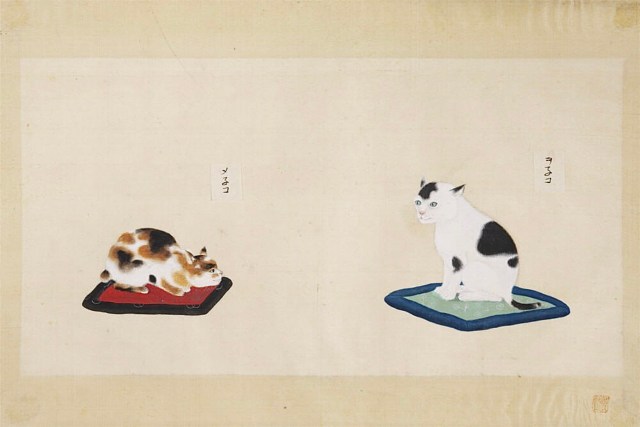
We start our matsuri, or festival, with work commissioned by Philip Franz von Siebold, German physician and botantist. In 1823, under the auspices of the Dutch East Indies Company he was posted to Dejima, an artificial island and trading post off the coast of Nagasaki. For over 200 years, first for the Portuguese and later for the Dutch, Dejima was the conduit for trade with Japan during the isolationist Edo period (1600-1869).
Siebold collected a vast number of plants that were later taken to Leiden. He taught western medical practices and he, along with others, documented Japanese flora, fauna, customs and culture. Siebold quickly began the multi-volume “Archiv zur Beschreibung Nippons” (Archive for Describing Japan). The archive included this illustration of tools:
Siebold was allowed to hire artist Kawahara Keiga (1786-1860?) to further their documentation efforts. Kawahara was taught western painting techniques by Carl Hubert de Villeneuve. He painted harbor scenes, plants, animals and all manner of things. His artwork included the hand tools used by Japanese craftsmen.
Kawahara painted on paper, wood and silk. An archive of his work is held by the Netherlands National Museum of Ethnology (Museum Volkenkunde Leiden). Below is a gallery of Japanese hand tools painted on silk by Kawahara. At the end of the gallery are three illustrations by other artists, each of which has been used in previous blog posts (now they are all together!). After the gallery is a link to use if you would like to see several more paintings of tools, boats, sea life and more.
The link to see more of Kawahara Keigo’s work:
https://collectie.wereldculturen.nl/#/query/01ce7653-73cf-430c-a39e-76fa51557c99
The link will take you to a Search Page. If it comes up in Dutch you can select your alternate language at the top right of the page. In the Search Box enter Kawahara Keigo and press Search. Use the Green Arrows on the right to advance to Page 11. Kawahara’s work is found on Pages 11 to 51.
Kawahara’s cats! After all, this is the Lost Art Press and Cats blog.
– Suzanne Ellison





























I had to search the name “Kawahara Keiga“ in order for the search results to appear. Just thought I’d share that in case anyone else was having difficulty.
I am glad you were able to find the paintings.
That is a very nice article and the link to the Dutch museum is great
Thanks!
Merci Suzanne !
Ça va, Maurice?
Tes images superbes sont un puissant reconstituant !
Thats awesome. Never seen most of these tools, only the “basics”. It’s interesting that the Mingei museum has some of this work. I live 20 minutes away and still haven’t been lol.
Well, Steve, it’s time to get yourself over there.
Beautiful illustrations, thank you for sharing them.
Thank you and you are welcome!
Yes, “Kawahara Keiga“ is the correct search-string that works for both the tool illustrations and so much more.
Thank you for this, Suzanne and LAP! I love these ancient and vintage tool and workshop illustrations of all kinds. The lived histories of our many cultures and entire species, as the masses of our ancestral people actually experienced them, is MUCH better told through our evolving tools and crafts than it is by our politics, wars, and kings. Many more of these illustrations should be at least as well known as Roubo’s Plate 11 that has inspired so many of us. These traditions should each have their own Slöyd-schools celebrating, preserving, demonstrating, and teaching their precious and hard-won accomplishments, knowledge and skills. If our “civilization” ever needs to be rebuilt after we have finally finished devastating it, this is how we will do it.
Thank you and well said.
This blog is for both lost arts press and lost cats?
Why yes, yes it is.
These are beautiful. Looking forward to seeing the additional works you linked to. Thanks!
-Chris